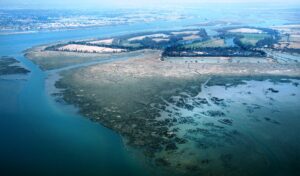Over the past 40 years, more than 100 tidal marsh restoration projects have been constructed in the Fraser River Estuary of British Columbia, Canada.
They are primarily intended to mitigate the loss of habitats from human activities and to maintain the ecological integrity of the area. More projects continue to be proposed.
However, reports have shown that the success of these restoration projects varies.Now, a new, in-depth report by Ducks Unlimited Canada (DUC)—the most comprehensive analysis of tidal marsh creation projects in the Fraser River Estuary to date—was published on March 31, 2022. It sheds light on factors that lead to some projects being more successful than others.
Starting in spring 2021, local wetland plant ecologist Daniel Stewart and DUC conservation technicians embarked on a study to assess 27 marsh restoration projects and nine natural reference marshes in the Fraser River Estuary and pooled these results with similar data from a 2016 report.
These data were used to model potential causes behind marsh recession, dominance of native plant species, and species richness in these sites.
Among their findings detailed in their report, entitled Factors Influencing the Persistence of Created Tidal Marshes in the Fraser River Estuary:
- Marsh recession was observed in 40 of the 78 surveyed created marshes (51 per cent), resulting in an estimated loss of 23,553 square meters, or 9.3 per cent of the total created marsh area sampled;
- There is no one factor that can determine the loss of marsh recession. Site design, boat wake, and the impact of grazing by Canada geese feeding are emphasized; however, altered sediment processes, sea-level rise, shading, and monitoring effectiveness are all possible causes, and warrant further investigation;
- While protective infrastructure, specifically debris fencing and offshore structures such as marina docks and log storage booms possibly mitigate recession, sites built in the North Arm of the Fraser River Estuary averaged 12 per cent more recession, and recession increased at an average rate of 1 per cent per kilometer upstream among sites; and
- The dominance of native vegetation declined at an average rate of one per cent per kilometer upriver in created marshes. This reflects an eastward increase in the dominance of non-native plants, including invasive species such as yellow flag iris, purple loosestrife, and reed canary grass.
Contrary to this trend, invasive cattail dominates several outer estuary sites. When present, cattails often outcompete native vegetation.
DUC conservation programs specialist and report co-author Eric Balke notes that “there are several sites that date back to the early 1990s that show no signs of recession and are absent of invasive species. This suggests that projects can be successful and somewhat resilient for decades if a site is properly designed, implemented, and monitored.”
According to Sarah Nathan, DUC’s manager of provincial operations for BC, “it’s important that we learn from the past so that future restoration projects are delivered in a way that is acceptably compensating for habitat losses.”
Balke says the report suggests that managers should plan around the inherent risks and trade-offs that come with the location design of a project. “For example, sites that are constructed further upriver may be more vulnerable to recession and dominance by non-native plants. Closed embayment designs may be more vulnerable to cattail invasions. And low elevation sites may be more resilient to species invasions but may be more vulnerable to recession,” he explained.
Nathan notes that findings from the report will bolster DUC’s ongoing efforts to apply its conservation knowledge to find solutions that will safeguard the vital habitats within this critical estuarine ecosystem.
“Working alongside our partners, we’ve been focused on restoring key wetland habitat, like lost tidal marsh surrounding the Fraser River, with the goal of renewing salmon stocks and improving habitat for a wide variety of marine life and waterfowl,” says Nathan. “We believe the Fraser River Estuary’s ability to flourish is helped by our commitment to on-the-ground conservation,” she said.
The Factors Influencing the Persistence of Created Tidal Marshes in the Fraser River Estuary report is the start of a longer investment by DUC over the next two years to restore tidal marshes throughout the estuary to support carbon sequestration and restore salmon habitat. DUC will use the findings from the report to inform restoration works and identify some unsuccessful compensation sites to restore.
Fraser River Estuary – importance and threats:
- Within the largest urban metropolis of Western Canada is a life-giving ecosystem known as the Fraser River Estuary: a vast network of channels, marshes, eelgrass meadows, and mud and sandflats;
- The estuary is an important overwintering area for waterfowl, a site of hemispheric significance for migratory shorebirds, and home to hundreds of millions of out-migrating juvenile salmon smolts that rely upon these brackish ecosystems to prepare their bodies for life in the ocean; and
- Urban and industrial expansion continues to chip away at the estuary’s ability to sustain its diversity of life. Pollution, widespread dredging and diking, urban sprawl, climate change and numerous large-scale current and future industrial developments threaten the estuary’s capacity to support the biodiversity that depends on it.
The study was funded by the BC Wildlife Federation Wetlands Workforce project and supported through the provincial Healthy Watersheds Initiative delivered by the Real Estate Foundation of BC and Watersheds BC, with the financial support from the Province of BC as part of its $10 billion COVID-19 response.
Photo of Wood Duck courtesy of Ducks Unlimited Canada / Ray Hennessy.
See Ducks Unlimited Canada website.
Request a copy of the report and learn more about DUC’s work in the Fraser River Estuary here.


